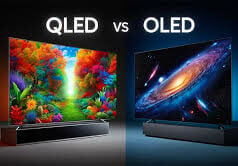
Today I will be talking about
LED TV and
LCD TV. LED stands for“LIGHT EMITTING DIODES(LCD),”television which is differ from general
LCD TV which stands for Light Crystal display which uses fluorescent lights while LEDs use those light emitting diodes.
Though LED TVs have taken on a name of their own, they are not so different from LCD technology. When comparing LED and LCD TVs, the difference lies in how the screen is lit to produce a bright picture. Traditional LCDs are backlit with standard fluorescent lights, where as LED Tvs are backlit using smaller and more energy-efficient LED lights.
If you’ve ever used an LED flashlight (or compared one to an ordinary flashlight), you can already make a good guess at the advantage of LED lighting: Your picture will be brighter and have better contrast. Additionally, LED TVs have deeper blacks than LCDs (important if you’re a movie buff), and the screens themselves are thinner and consume less power. In the battle of LCD Tv vs. LED Tv technology, LED TVs definitely come out on top.LCD Tv stands for “liquid crystal display” and technically, both LED Tv and LCD TVs are liquid crystal displays. The basic technology is the same in that both television types have two layers of polarized glass through which the liquid crystals both block and pass light. So really, LED TVs are a subset of LCD TVs.
LED, which stands for “LIGHT EMITTING DIODES(LCD),” differs from general
LCD TVs in that
LCD Tvs use fluorescent lights while LEDs use those light emitting diodes. Also, the placement of the lights on an LED TV can differ. The fluorescent lights in an
LCD TV are always behind the screen. On an
LED TV, the light emitting diodes can be placed either behind the screen or around its edges. The difference in lights and in lighting placement has generally meant that LED TVs can be thinner than LCDs, although this is starting to change. It has also meant that
LED TVs run with greater energy efficiency and can provide a clearer, better picture than the general
LCD TVs.
LED TVs provide a better picture for two basic reasons. First,
LED TVs work with a color wheel or distinct RGB-colored lights (red, green, blue) to produce more realistic and sharper colors. Second, light emitting diodes can be dimmed. The dimming capability on the back lighting in an
LED TV allows the picture to display with a truer black by darkening the lights and blocking more light from passing through the panel. This capability is not present on edge-lit
LED TVs; however, edge-lit
LED TVs can display a truer white than the fluorescent
LED TVs.
Because all these
LCD TVs are thin-screen, each has particular angle-viewing and anti-glare issues. The back-lit TVs provide better, cleaner angle viewing than the edge-lit LED TV. However, the back-lit
LED TV will usually have better angle viewing than the standard
LCD TV. Both LED and
LCD TVs have good reputations for their playback and gaming quality












[…] LED TELEVISION VERSUS LCD TELEVISION […]